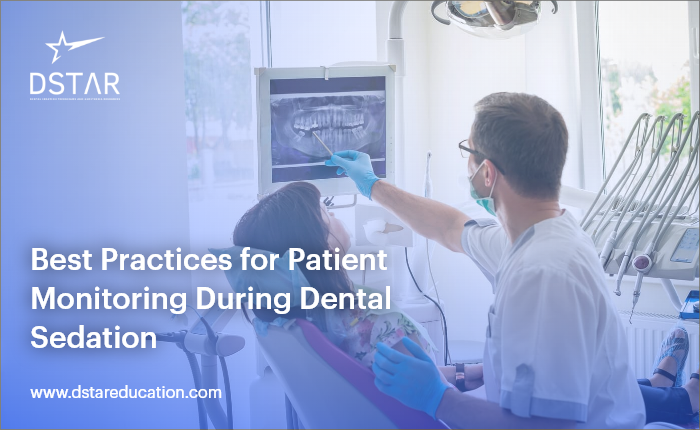Understanding the 5 levels of sedation is important for clinicians performing dental procedures that require pharmacological management of patient anxiety, pain, or reflex control. The classification of sedation into defined stages ensures that the dental team adheres to regulatory protocols, maintains patient safety, and applies sedation within the scope of their licensure.
Although commonly referred to as the “4 levels of sedation,” a clinically expanded interpretation includes a fifth, transitional level that carries implications for both procedural planning and legal compliance.
In Texas, your dental anesthesia/sedation permit is renewed on the same schedule as your dentist license, every two years, and you must complete the required sedation-level continuing education during that cycle.
This guide provides a comprehensive overview of the types of sedation, the stages of sedation, their clinical applications, and the levels of sedation anesthesia as recognized by regulatory agencies. It also explores the levels of sedation charted most frequently in practice and licensing exams.
1. Minimal Sedation (Anxiolysis)
Minimal sedation represents the first tier in the levels of sedation. At this stage, patients remain fully conscious and can respond normally to verbal commands. Cognitive function may be slightly impaired, but airway reflexes and cardiovascular function remain unaffected.
Clinical Use
Minimal sedation is frequently used in pediatric and adult settings to manage procedural anxiety without impairing responsiveness. Dentists often achieve this level through oral administration of benzodiazepines or inhalation of low-dose nitrous oxide.
Must Read: Sedation Recertification in Pediatric Dentistry
Legal Note
In many jurisdictions, including Texas, minimal sedation may not require a sedation permit unless administered in conjunction with other agents that risk deepening the stage. Understanding the sedation permit levels in Texas is important for remaining within scope.
Relevance to Practice
Minimal sedation is a foundational component in the levels of sedation chart used for procedural planning and staff training. It is included in all clinical discussions of the 4 levels of sedation, though it is not considered anesthesia.
2. Moderate Sedation (Conscious Sedation)
Moderate sedation is the second classification in the progression of stages of sedation. Patients under moderate sedation experience a depression of consciousness but can still respond purposefully to verbal or tactile stimulation. Protective airway reflexes remain intact, and spontaneous ventilation is adequate.
Clinical Use
This level is common in complex restorative procedures, periodontal surgeries, and pediatric extractions. The types of sedation used here typically include oral sedatives combined with nitrous oxide, or intravenous benzodiazepines like midazolam.
Monitoring Requirements
Texas regulations mandate pulse oximetry, blood pressure monitoring, and documentation protocols for moderate sedation. These measures align with levels of sedation anesthesia defined by both the American Dental Association and the Texas State Board of Dental Examiners.
Permit Requirements
Dentists administering moderate sedation must comply with specific sedation permit levels in Texas, including renewal CE and equipment standards.
3. Deep Sedation
Deep sedation occupies the third stage in the levels of sedation continuum. At this level, patients cannot be easily aroused but will respond purposefully after repeated or painful stimulation. A healthcare provider may need to perform airway intervention when spontaneous ventilation proves inadequate.
Clinical Use
This level reserved for extensive oral surgeries or procedures involving high anxiety or gag reflexes. Agents often include higher doses of IV sedatives or combinations of benzodiazepines and narcotics.
Risks and Oversight
Due to its proximity to general anesthesia, deep sedation requires stringent compliance. Monitoring must include capnography, continuous ECG, and emergency drug availability.
Regulatory Context
According to sedation permit levels in Texas, deep sedation necessitates the highest level of training, facility preparedness, and emergency protocol documentation.
4. General Anesthesia
General anesthesia is the final stage among the traditional 4 levels of sedation. It involves a complete loss of consciousness. Patients do not respond to any stimulation and require airway management, ventilatory support, and cardiovascular monitoring.
Application Scope
This level typically managed by a dental anesthesiologist or medical anesthesiologist in hospital-based or specially equipped office settings.
Pharmacologic Profile
Agents include IV propofol, ketamine, or inhalation anesthetics like sevoflurane. These drugs eliminate patient awareness and often induce amnesia.
Legal Considerations
Sedation permit levels in Texas require dentists to hold a Level 4 permit for general anesthesia administration. Permit holders must also undergo periodic inspection and renewal, with CE focused on emergency airway management.
Read in Detail: Common Legal Violations in Sedation CE and How to Avoid Them
5. Transitional Sedation (Sub-Anesthetic State)
Although not formally listed among the 4 levels of sedation, a transitional sedation state is clinically recognized in advanced dental sedation literature. This fifth level refers to a pharmacologic state that fluctuates between moderate and deep sedation.
Clinical Significance
In this stage, patients may unpredictably transition from moderate to deep sedation, particularly with cumulative dosing or patient-specific metabolism.
Risk Management
Practitioners must monitor for unintended deepening of sedation levels, especially during long or invasive sedation dentistry procedures.
Chart Recognition
The most updated levels of sedation charts now include transitional descriptors to guide dosage adjustments and monitoring protocols.
Understanding the Levels of Sedation Chart
| Level | Sedation Type | Patient Responsiveness | Airway Reflexes | Monitoring Requirements | Common Agents |
| 1 | Analgesia Only | Normal response to verbal stimulation; only pain relief | Fully intact | Basic vitals (BP, HR, SpO₂) | Low-dose opioids, NSAIDs, nitrous oxide ≤ 30% |
| 2 | Minimal Sedation (Anxiolysis) | Normal response to verbal commands; reduced anxiety | Intact | Standard vitals + visual observation | Oral benzodiazepines, nitrous oxide 30–50% |
| 3 | Moderate Sedation (Conscious) | Purposeful response to verbal or light tactile stimuli | Usually intact | Vitals + capnography; supplemental O₂ recommended | IV benzodiazepines + low-dose opioids |
| 4 | Deep Sedation | Purposeful response only after repeated or painful stimuli | May be impaired; partial obstruction risk | Continuous vitals, capnography, trained airway support | Propofol, higher-dose opioids |
| 5 | General Anesthesia | Unarousable even with painful stimulus | Abolished; always requires airway device | Full anesthesia monitoring (EKG, end-tidal CO₂, invasive BP if needed) | Inhaled agents (sevoflurane), IV induction drugs |
The levels of sedation chart is a visual aid commonly used in training programs and office protocols. It defines the stages of sedation, correlates them with clinical signs, and outlines permissible interventions. Dentists and staff refer to this chart during sedation dentistry procedures to ensure real-time compliance and patient safety.
Elements Typically Included
- Level designation (Minimal, Moderate, Deep, General)
- Patient responsiveness
- Airway integrity
- Ventilation requirements
- Cardiovascular function
This chart plays an important role in defining the boundaries between types of sedation and identifying when intervention thresholds crossed.
Pharmacologic Agents by Sedation Level
Each level of sedation corresponds with specific pharmacologic agents. Understanding the mechanism of action and titration strategies is important for safe and effective sedation delivery.
Examples:
- Minimal Sedation: Diazepam, hydroxyzine, low-dose nitrous oxide
- Moderate Sedation: Midazolam, fentanyl, moderate-dose nitrous oxide
- Deep Sedation: Propofol, ketamine, high-dose benzodiazepines
- General Anesthesia: Sevoflurane, isoflurane, high-dose IV agents
The stages of sedation reflect these pharmacological distinctions, which must be documented in all sedation dentistry procedures.
Texas Regulatory Framework and Permit Levels
In Texas, the Texas State Board of Dental Examiners categorizes sedation permit levels according to depth of sedation and required facility standards. Dentists must hold appropriate permits, maintain BLS/ACLS/PALS certification, and demonstrate CE compliance.
Permit Levels:
- Level 1: Nitrous oxide/Minimal Sedation
- Level 2: Enteral/Moderate Sedation
- Level 3: Parenteral/Moderate Sedation (IV)
- Level 4: Deep Sedation and General Anesthesia
Understanding the relationship between sedation permit levels in Texas and the clinical levels of sedation ensures full legal compliance.
Conclusion
Clinicians must master the nuances among the 4 levels of sedation and understand how a fifth, transitional level influences decision-making. Knowing the types of sedation, pharmacologic implications, monitoring standards, and licensing requirements protects both patient safety and provider liability.
Each stage in the levels of sedation anesthesia has specific clinical, legal, and procedural criteria. The levels of sedation chart serves as a reference point for applying the correct sedation method based on the patient’s needs and procedural complexity. From minimal anxiolysis to complete unconsciousness under general anesthesia, proper training and documentation are mandatory.
Dentists practicing in Texas must align all sedation dentistry procedures with current TSBDE regulations and maintain their sedation permit levels accordingly. This includes rigorous documentation, training in emergency protocols, and continuous CE.
References
- Centers for Disease Control and Prevention (CDC)
Safe Injection Practices and Monitoring During Sedation
https://www.cdc.gov/injectionsafety - Journal of the American Dental Association (JADA)
“Sedation and Anesthesia in Dental Practice”
https://jada.ada.org - National Institutes of Health (NIH)
Clinical use and risks of dental sedation
https://www.ncbi.nlm.nih.gov/pmc/articles/PMC5808033 - American Academy of Pediatric Dentistry (AAPD)
Clinical Guidelines on Behavior Guidance and Sedation in Pediatric Dental Patients
https://www.aapd.org/research/oral-health-policies–recommendations - American Association of Oral and Maxillofacial Surgeons (AAOMS)
Office-Based Anesthesia Guidelines
https://www.aaoms.org/practice-resources/anesthesia - Health and Human Services Commission (HHSC), Texas
Healthcare licensing and safety information related to sedation practices
https://www.hhs.texas.gov
 Take Free TSBDE Anesthesia Jurisprudence Practice Exam Now!
Take Free TSBDE Anesthesia Jurisprudence Practice Exam Now!












